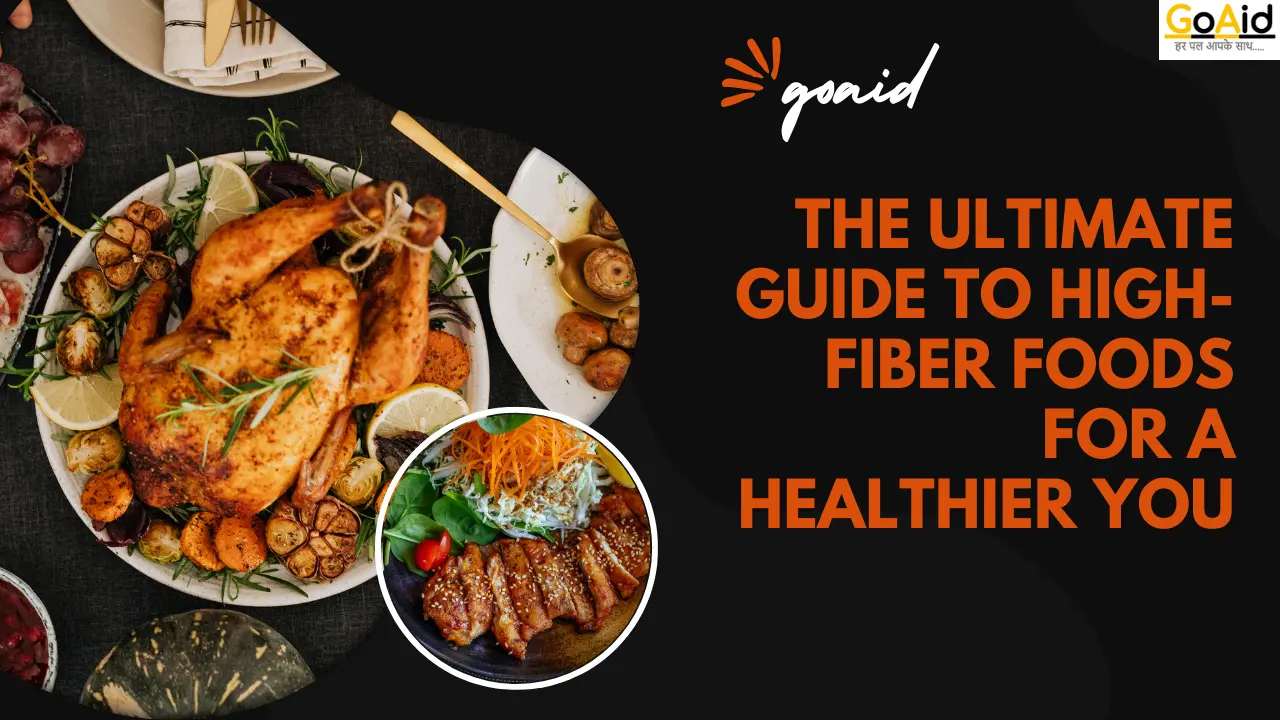Not only in India, but in the entire world, more than 1/3 of the whole population is facing problems with digestive health, weight management, blood sugar control, heart health, gut health, detoxification, nitrifications, and much more. But do you know there is one thing that can help you and the entire 1/3 of this population tackle these health and disease issues: high-fiber meals and food? If you can increase the high-fiber intake in your diet, then there is a big possibility to handle all of these health-related problems.
Now you must be excited to find the high-fiber foods that can make you healthier, right? ThatŌĆÖs all right! In this blog, we have provided The Ultimate Guide to High-Fiber Foods for a Healthier You. If you are looking to find high-fiber foods, vegetables, meals, diet, and everything, then in this blog, youŌĆÖll be able to get complete information about them.
So, letŌĆÖs start-
What are Fibers in Food?
Fiber, also known as roughage or bulk, is a carbohydrate found in plant-based foods that the body cannot digest. Unlike other carbs broken down into sugar molecules, fiber passes through the digestive tract relatively intact.
There are two types of fiber: soluble and insoluble. Soluble fiber dissolves in water to form a gel-like substance, helping to lower blood cholesterol and glucose levels. Insoluble fiber, on the other hand, adds bulk to the stool and aids in regular bowel movements. Both types are crucial for maintaining digestive health, regulating blood sugar, and supporting overall well-being.
Read More: Best Diet for Diabetes Control
Why do we need fiber in the food?
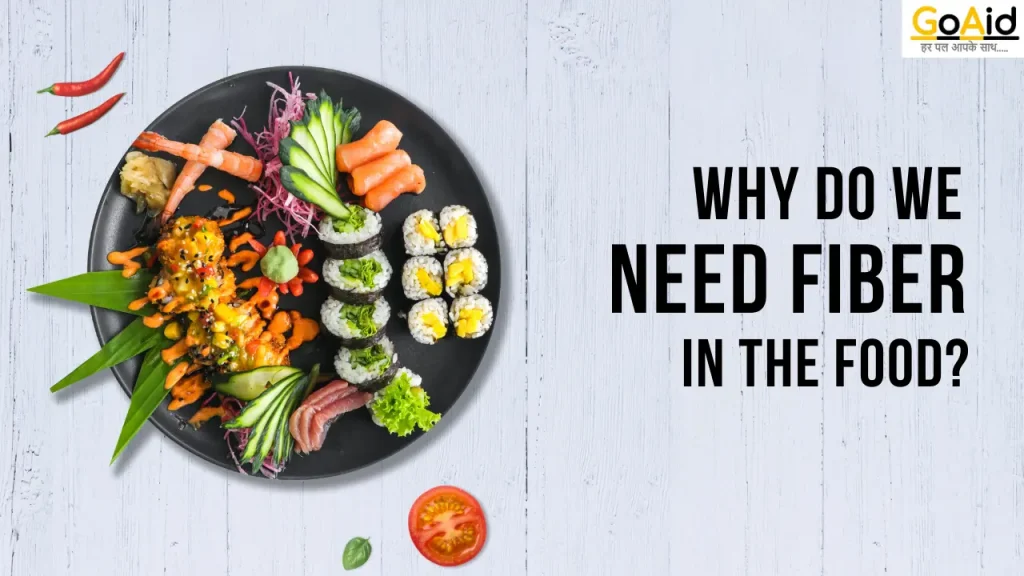
Fiber is an essential component of a healthy diet, playing a critical role in various bodily functions and offering numerous health benefits. Here’s a detailed look at why we need fiber in our food:
1. Digestive Health
- Regular Bowel Movements: Fiber adds bulk to the stool, making it easier to pass and preventing constipation. Insoluble fiber, in particular, helps move material through the digestive system and increases stool bulk.
- Preventing Digestive Disorders: A high-fiber diet can reduce the risk of developing certain digestive disorders, such as diverticulitis, hemorrhoids, and irritable bowel syndrome (IBS).
2. Weight Management
- Increased Satiety: High-fiber foods are more filling than low-fiber foods, helping to control appetite and reduce overall calorie intake. This can be particularly beneficial for weight management and obesity prevention.
- Slower Digestion: Fiber slows down the digestion process, which helps you feel full for a longer period and can prevent overeating.
3. Blood Sugar Control
- Improved Glycemic Control: Soluble fiber slows the absorption of sugar, helping to stabilize blood sugar levels and prevent spikes after meals. This is especially important for individuals with diabetes or insulin resistance.
- Lower Risk of Type 2 Diabetes: A diet rich in high-fiber foods is associated with a reduced risk of developing type 2 diabetes.
4. Heart Health
- Lower Cholesterol Levels: Soluble fiber can help lower total blood cholesterol levels by reducing low-density lipoprotein (LDL) or “bad” cholesterol. It binds to cholesterol in the digestive system and helps remove it from the body.
- Reduced Blood Pressure and Inflammation: A high-fiber diet can help reduce blood pressure and inflammation, which are risk factors for heart disease.
5. Gut Health
- Prebiotic Effects: Fiber acts as a prebiotic, providing nourishment for beneficial gut bacteria. A healthy gut microbiome is crucial for overall health, including immune function and mental well-being.
- Enhanced Digestive Function: By promoting the growth of healthy bacteria, fiber helps maintain a balanced gut environment and supports optimal digestive function.
6. Lower Risk of Certain Diseases
- Colorectal Cancer: A diet high in fiber is associated with a reduced risk of colorectal cancer. Fiber helps to keep the digestive tract clean and functioning efficiently, reducing the chances of cancerous growth.
- Other Chronic Diseases: High-fiber diets have been linked to a lower risk of developing various chronic diseases, including stroke, hypertension, and certain types of cancer.
7. Detoxification
- Toxin Removal: Fiber aids in the removal of toxins from the body by binding to them and facilitating their elimination through the digestive system. This can help reduce the overall toxic load on the body.
8. Nutrient Absorption
- Improved Absorption: Fiber can slow down the digestion process, allowing for better absorption of nutrients in the intestines. This ensures that the body gets the most benefit from the foods consumed.
Also Read: Introduction to the Importance of Health
Characteristics of High-Fiber Foods
High-fiber foods are distinguished by several key characteristics that contribute to their health benefits. HereŌĆÖs an in-depth look at these characteristics:
1. Rich in Plant-Based Nutrients
- Whole Grains: Foods like oats, barley, quinoa, and brown rice are high in fiber and essential nutrients such as vitamins, minerals, and antioxidants.
- Fruits and Vegetables: These are naturally high in fiber and also provide vitamins, minerals, and phytonutrients essential for health.
2. Types of Fiber
- Soluble Fiber: Dissolves in water to form a gel-like substance. Found in foods like oats, beans, apples, and citrus fruits, it helps lower blood cholesterol and glucose levels.
- Insoluble Fiber: Does not dissolve in water. Found in whole grains, nuts, seeds, and vegetables like cauliflower and potatoes, it helps add bulk to the stool and promotes regular bowel movements.
3. Low in Calories
- Filling Yet Low-Calorie: High-fiber foods tend to be low in calories but very filling, which helps control appetite and can aid in weight management.
4. High Water Content
- Hydration and Satiety: Many high-fiber foods, particularly fruits and vegetables, have a high water content, which adds bulk without additional calories, helping to keep you hydrated and full.
5. Low Glycemic Index
- Slow Release of Glucose: High-fiber foods often have a low glycemic index, meaning they cause a slower, more gradual rise in blood sugar levels. This is beneficial for managing blood sugar levels, particularly for people with diabetes.
6. Minimal Processing
- Whole and Unrefined: Foods high in fiber are usually less processed. Whole foods like fruits, vegetables, whole grains, legumes, nuts, and seeds retain their natural fiber content, unlike processed foods which often have their fiber removed.
7. Rich in Micronutrients
- Vitamins and Minerals: High-fiber foods are also rich in essential vitamins and minerals, including B vitamins, vitamin C, potassium, and magnesium, contributing to overall nutritional value.
8. High in Antioxidants
- Disease Prevention: Many high-fiber foods are rich in antioxidants, which help protect the body from oxidative stress and reduce the risk of chronic diseases.
9. Fermentable Fibers
- Prebiotics: Some fibers, like inulin and oligosaccharides, act as prebiotics, feeding beneficial gut bacteria and promoting a healthy gut microbiome.
10. Versatility
- Culinary Uses: High-fiber foods are versatile and can be easily incorporated into a variety of dishes, from salads and soups to main courses and snacks.
11. Satiation
- Longer Digestion Time: High-fiber foods take longer to chew and digest, which helps increase feelings of fullness and reduces the likelihood of overeating.
Also Read: Importance of Regular Health Check-Ups
Examples of High-Fiber Foods
- Legumes: Beans, lentils, and peas are excellent sources of both soluble and insoluble fiber.
- Nuts and Seeds: Almonds, chia seeds, flaxseeds, and sunflower seeds are high in fiber and healthy fats.
- Whole Fruits: Apples, berries, oranges, and pears are fiber-rich, especially when eaten with the skin.
- Vegetables: Broccoli, Brussels sprouts, carrots, and sweet potatoes are notable for their high fiber content.
- Whole Grains: Brown rice, barley, oats, and whole wheat products provide a substantial amount of dietary fiber.
Benefits of High Fiber Diet
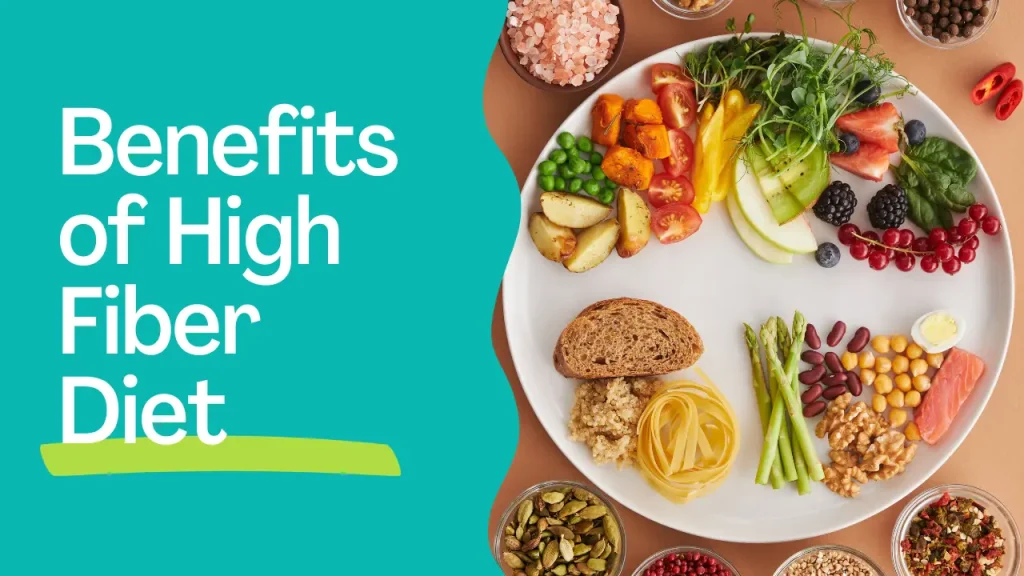
These are the key benefits of High-Fiber Diet:
- Improves Digestive Health: Promotes regular bowel movements and prevents constipation.
- Aids Weight Management: Increases satiety, reducing overall calorie intake.
- Controls Blood Sugar Levels: Slows sugar absorption, helping to stabilize blood sugar levels.
- Lowers Cholesterol: Reduces levels of LDL (bad) cholesterol, improving heart health.
- Supports Heart Health: Lowers blood pressure and reduces inflammation.
- Enhances Gut Health: Acts as a prebiotic, nourishing beneficial gut bacteria.
- Reduces Disease Risk: Lowers the risk of colorectal cancer, stroke, and other chronic diseases.
- Aids Detoxification: Helps remove toxins from the body through the digestive tract.
- Improves Nutrient Absorption: Slows digestion, allowing for better absorption of nutrients.
- Boosts Overall Well-Being: Contributes to a balanced diet, providing essential vitamins and minerals.
Best High-Fiber Foods List
This is a comprehensive list of High Fiber Foods List:
| SN | Names of High-Fiber Food | Nutrients / Specifications | Benefit of Food | Fiber Contains |
| High-Fiber Fruits and Vegetables | ||||
| 1 | Apples | Soluble fiber, vitamin C, potassium | Soluble fiber (pectin) aids in digestion, helps regulate blood sugar and supports heart health. | 4.4 grams in a Apple |
| 2 | Pears | Soluble and insoluble fiber, vitamin C, copper | High in both soluble and insoluble fiber, pears improve bowel regularity and support heart health. | About 5.5 grams per medium pear. |
| 3 | Raspberries | Soluble fiber, vitamin C, manganese | Rich in soluble fiber, they enhance digestive health and provide antioxidants. | About 8 grams per cup. |
| 4 | Strawberries | Soluble fiber, vitamin C, manganese | Contains soluble fiber, which supports immune function and promotes skin health. | About 3 grams per cup. |
| 5 | Avocados | Soluble and insoluble fiber, healthy fats, vitamin E | Rich in both soluble and insoluble fiber, avocados support heart health and aid digestion. | About 10 grams per medium avocado. |
| 6 | Bananas | Soluble fiber, vitamin B6, potassium | Contains soluble fiber, which helps regulate blood sugar levels and supports heart health. | About 3.1 grams per medium banana. |
| 7 | Oranges | Soluble fiber, vitamin C, folate | High in soluble fiber, oranges boost the immune system and improve skin health. | Boosts immune system and improves skin health |
| 8 | Carrots | Insoluble fiber, beta-carotene, vitamin K | Insoluble fiber supports eye health and improves digestion. | About 3.6 grams per cup (raw). |
| 9 | Beets | Soluble fiber, folate, manganese | Soluble fiber supports liver health and enhances athletic performance. | About 3.8 grams per cup. |
| 10 | Broccoli | Soluble and insoluble fiber, vitamin C, vitamin K | Contains both soluble and insoluble fiber, boosting immune function and supporting bone health. | About 5.1 grams per cup. |
| 11 | Brussels Sprouts | Soluble and insoluble fiber, vitamin K, vitamin C | High in both types of fiber, promoting digestive health and bone health. | About 4 grams per cup. |
| 12 | Artichokes | Soluble fiber, vitamin C, magnesium | Soluble fiber supports liver health and aids digestion. | About 10.3 grams per medium artichoke. |
| 13 | Sweet Potatoes | Insoluble fiber, beta-carotene, vitamin C | Rich in insoluble fiber, supporting eye health and boosting immune function. | About 4 grams per medium sweet potato. |
| 14 | Lentils | Soluble and insoluble fiber, protein, iron | High in both soluble and insoluble fiber, supporting muscle health and improving digestion. | About 15.6 grams per cup (cooked). |
| 15 | Chickpeas | Soluble and insoluble fiber, protein, folate | Rich in both types of fiber, supporting heart health and aiding weight management. | About 12.5 grams per cup (cooked). |
| 16 | Black Beans | Soluble and insoluble fiber, protein, iron | High in both types of fiber, supporting muscle health and improving digestion. | About 15 grams per cup (cooked). |
| 17 | Kidney Beans | Soluble and insoluble fiber, protein, folate | Rich in both types of fiber, supporting heart health and aiding weight management. | About 13.1 grams per cup (cooked). |
| 18 | Quinoa | Soluble and insoluble fiber, protein, magnesium | Contains both soluble and insoluble fiber, supporting muscle health and promoting bone health. | About 5.2 grams per cup (cooked). |
| 19 | Barley | Soluble fiber, manganese, selenium | High in soluble fiber, supporting heart health and aiding digestion. | About 6 grams per cup (cooked). |
| 20 | Oats | Soluble fiber, protein, iron | Rich in soluble fiber (beta-glucan), lowering cholesterol levels and supporting heart health. | About 4 grams per cup (cooked). |
| 21 | Brown Rice | Insoluble fiber, magnesium, selenium | Contains insoluble fiber, supporting bone health and improving digestion. | About 3.5 grams per cup (cooked). |
| 22 | Almonds | Insoluble fiber, healthy fats, vitamin E | Rich in insoluble fiber, supporting heart health and promoting skin health. | About 3.5 grams per ounce (23 almonds). |
| 23 | Chia Seeds | Soluble and insoluble fiber, omega-3 fatty acids, calcium | Contains both soluble and insoluble fiber, supporting heart health and boosting energy levels. | About 10.6 grams per ounce (2 tablespoons). |
| 24 | Flaxseeds | Soluble and insoluble fiber, omega-3 fatty acids, lignans | High in both types of fiber, supporting heart health and aiding digestion. | About 7.6 grams per ounce (2 tablespoons). |
| 25 | Sunflower Seeds | Insoluble fiber, healthy fats, vitamin E | Rich in insoluble fiber, supporting heart health and promoting skin health. | About 3 grams per ounce. |
| 26 | Walnuts | Insoluble fiber, healthy fats, omega-3 fatty acids | High in insoluble fiber, supporting brain health and promoting heart health. | About 2 grams per ounce (14 halves). |
| 27 | Popcorn | Insoluble fiber, low in calories | Rich in insoluble fiber, supporting weight management and aiding digestion. | About 3.6 grams per 3 cups (air-popped). |
| 28 | Whole Wheat Bread | Insoluble fiber, B vitamins, iron | Contains insoluble fiber, supporting heart health and improving digestion. | About 2 grams per slice. |
| 29 | Peas | Soluble and insoluble fiber, protein, vitamin K | Rich in both types of fiber, supporting muscle health and promoting bone health. | About 8.8 grams per cup (cooked). |
| 30 | Prunes | Soluble and insoluble fiber, sorbitol, vitamin K | High in both types of fiber and sorbitol, aiding digestion and supporting bone health. | About 12 grams per cup. |
High-Fiber Fruits and Vegetables
High-fiber fruits and vegetables are essential components of a balanced diet, providing a range of nutrients and health benefits. Here’s a detailed overview of some of the most notable high-fiber fruits and vegetables:
High-Fiber Fruits
1. Apples
- Fiber Content: About 4.4 grams per medium apple.
- Types of Fiber: Soluble fiber (pectin).
- Benefits: Aids digestion by promoting regular bowel movements, supports heart health by lowering cholesterol levels, and boosts immune function due to its vitamin C content.
2. Pears
- Fiber Content: About 5.5 grams per medium pear.
- Types of Fiber: Both soluble and insoluble fiber.
- Benefits: Helps maintain bowel regularity and digestive health, supports heart health by reducing the risk of heart disease, and provides antioxidants such as vitamin C.
3. Raspberries
- Fiber Content: About 8 grams per cup.
- Types of Fiber: Primarily soluble fiber.
- Benefits: Enhances digestive health by promoting regular bowel movements, provides antioxidants that protect against cell damage and supports immune function with its vitamin C and manganese content.
4. Strawberries
- Fiber Content: About 3 grams per cup.
- Types of Fiber: Soluble fiber.
- Benefits: Supports digestive health by aiding in regular bowel movements, boosts immune function due to its high vitamin C content, and promotes skin health with antioxidants that combat free radicals.
5. Avocados
- Fiber Content: About 10 grams per medium avocado.
- Types of Fiber: Both soluble and insoluble fiber.
- Benefits: Aids digestion by promoting healthy gut bacteria, supports heart health by lowering cholesterol levels and provides vitamin E and healthy fats that benefit skin and eye health.
6. Bananas
- Fiber Content: About 3.1 grams per medium banana.
- Types of Fiber: Soluble fiber.
- Benefits: Helps regulate bowel movements and relieve constipation, supports heart health by maintaining blood pressure, and provides vitamin B6 and potassium for overall health.
7. Oranges
- Fiber Content: About 3.1 grams per medium orange.
- Types of Fiber: Soluble fiber.
- Benefits: Supports digestive health by aiding in regular bowel movements, boosts immune function with vitamin C, and provides folate for cell growth and repair.
High-Fiber Vegetables
1. Carrots
- Fiber Content: About 3.6 grams per cup (raw).
- Types of Fiber: Primarily insoluble fiber.
- Benefits: Supports digestive health by adding bulk to stool, promotes eye health with beta-carotene, and provides vitamin K for blood clotting and bone health.
2. Broccoli
- Fiber Content: About 5.1 grams per cup.
- Types of Fiber: Both soluble and insoluble fiber.
- Benefits: Aids digestion by promoting regular bowel movements, supports immune function with vitamin C, and promotes bone health with vitamin K and calcium.
3. Brussels Sprouts
- Fiber Content: About 4 grams per cup.
- Types of Fiber: Both soluble and insoluble fiber.
- Benefits: Enhances digestive health by supporting gut bacteria, provides vitamin C for immune function, and supplies folate for cell growth and repair.
4. Artichokes
- Fiber Content: About 10.3 grams per medium artichoke.
- Types of Fiber: Primarily soluble fiber.
- Benefits: Supports digestive health by promoting regular bowel movements, aids liver health with antioxidants, and provides magnesium for muscle function.
5. Sweet Potatoes
- Fiber Content: About 4 grams per medium sweet potato.
- Types of Fiber: Insoluble fiber.
- Benefits: Supports digestive health by adding bulk to stool, promotes eye health with beta-carotene, and provides vitamin A for immune function and skin health.
Read More: Dehydration: Causes, Treatment, Prevention and How Much Water You Should Drink
How to Increase Fiber Intake
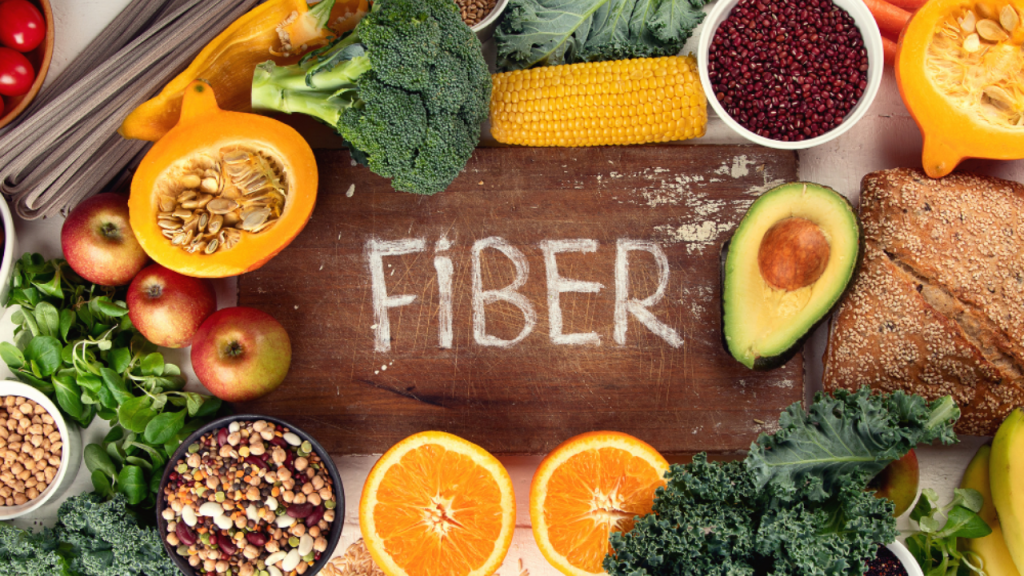
Increasing fiber intake is beneficial for overall health, supporting digestion, heart health, and weight management. HereŌĆÖs a comprehensive guide on how to increase fiber intake effectively:
1. Gradual Increase
- Start Slowly: Rapidly increasing fiber intake can cause digestive discomfort. Begin by adding small amounts of fiber-rich foods to your diet and gradually increase over several weeks.
2. Choose High-Fiber Foods
- Whole Grains: Opt for whole wheat bread, brown rice, oats, quinoa, and whole grain cereals.
- Legumes: Include beans, lentils, chickpeas, and peas in soups, salads, and main dishes.
- Fruits: Eat whole fruits with skins such as apples, pears, berries, and oranges.
- Vegetables: Consume a variety of vegetables like broccoli, Brussels sprouts, carrots, and leafy greens.
3. Include Fiber-Rich Snacks
- Nuts and Seeds: Snack on almonds, chia seeds, flaxseeds, and pumpkin seeds.
- Popcorn: Choose air-popped popcorn for a low-calorie, high-fiber snack.
- Fruit: Enjoy fresh fruits or dried fruits like prunes or figs as snacks.
4. Read Food Labels
- Look for Fiber Content: Check nutrition labels and choose foods with higher fiber content per serving.
5. Choose Whole Fruits and Vegetables
- Eat Whole Fruits: Opt for whole fruits over fruit juices, which often have less fiber and more sugar.
- Keep the Skin: Eat fruits and vegetables with their skins whenever possible, as the skin is often rich in fiber.
6. Add Fiber to Meals
- Smoothies: Blend fruits, vegetables, and chia seeds for a fiber-rich breakfast or snack.
- Salads: Include beans, nuts, seeds, and a variety of colorful vegetables in your salads.
- Soups and Stews: Add lentils, beans, or barley to soups and stews for extra fiber and texture.
7. Substitute High-Fiber Options
- Whole Grain Products: Choose whole-grain versions of pasta, bread, and cereals instead of refined grains.
- Snacks: Replace low-fiber snacks with high-fiber alternatives like whole fruits, nuts, or yogurt with added fiber.
8. Stay Hydrated
- Drink Plenty of Water: Fiber absorbs water, so staying hydrated helps prevent constipation and aids digestion.
9. Monitor Fiber Intake
- Track Daily Intake: Use a food diary or nutrition app to monitor your fiber intake and ensure you’re meeting recommended daily amounts.
10. Consider Fiber Supplements
- Consult a Doctor: If you struggle to get enough fiber from food alone, consider fiber supplements. Consult your healthcare provider before starting any supplements.
11. Balance Fiber Intake
- Mix Types of Fiber: Include both soluble and insoluble fiber-rich foods for overall digestive health benefits.
Read More: What is Diabetes? ŌĆō Top-10 Tips to Prevent Diabetes ŌĆō Complete Guide
High-Fiber Breakfast Ideas
These are the best High-Fiber Breakfast Ideas you can incorporate with them. By incorporating these high-fiber breakfast ideas into your morning routine, you can boost your fiber intake, support digestive health, and maintain overall well-being
1. Overnight Oats with Berries and Chia Seeds
Ingredients:
- Rolled oats
- Greek yogurt (optional)
- Milk (dairy or plant-based)
- Chia seeds
- Fresh berries (e.g., strawberries, blueberries)
Instructions:
- Mix rolled oats, chia seeds, Greek yogurt (if using), and milk in a jar or bowl.
- Refrigerate overnight.
- In the morning, top with fresh berries.
Benefits
- Oats and chia seeds are high in fiber, while berries add antioxidants and natural sweetness.
2. Whole Grain Toast with Avocado and Poached Egg
Ingredients:
- Whole grain bread (high-fiber variety)
- Avocado
- Eggs
- Salt and pepper (to taste)
Instructions:
- Toast whole grain bread.
- Mash avocado and spread it on the toast.
- Top with a poached egg.
- Season with salt and pepper.
Benefits
- Whole grain bread provides fiber, avocado adds healthy fats and fiber, and eggs offer protein.
3. Greek Yogurt Parfait with Granola and Fruit
Ingredients:
- Greek yogurt (plain or flavored)
- High-fiber granola
- Fresh fruit (e.g., bananas, berries)
Instructions:
- Layer Greek yogurt, granola, and fresh fruit in a glass or bowl.
Benefits
- Greek yogurt provides protein, granola adds fiber, and fruit contributes vitamins and minerals.
4. Spinach and Mushroom Omelette with Whole Grain Toast
Ingredients:
- Eggs
- Spinach
- Mushrooms
- Whole grain bread
- Olive oil
- Salt and pepper (to taste)
Instructions:
- Saute spinach and mushrooms in olive oil until wilted.
- Whisk eggs and pour over the vegetables in a pan.
- Cook until eggs are set, then fold over.
- Serve with whole-grain toast.
Benefits
- Eggs are protein-rich, spinach and mushrooms add fiber and nutrients, and whole-grain toast provides additional fiber.
5. Berry and Banana Smoothie Bowl
Ingredients:
- Frozen berries (e.g., strawberries, blueberries)
- Banana
- Greek yogurt
- Almond milk (or any milk of choice)
- Chia seeds
- Toppings: sliced almonds, shredded coconut
Instructions:
- Blend frozen berries, bananas, Greek yogurt, and almond milk until smooth.
- Pour into a bowl and sprinkle with chia seeds, almonds, and coconut.
Benefits
- Berries and bananas are high in fiber and antioxidants, while chia seeds add omega-3s and fiber.
6. Quinoa Breakfast Bowl with Nuts and Dried Fruit
Ingredients:
- Cooked quinoa
- Almond milk (or any milk of choice)
- Nuts (e.g., almonds, walnuts)
- Dried fruit (e.g., raisins, cranberries)
- Honey or maple syrup (optional)
Instructions:
- Warm-cooked quinoa with almond milk on the stove.
- Stir in nuts and dried fruit.
- Sweeten with honey or maple syrup if desired.
Benefits
- Quinoa is a high-fiber grain, nuts add healthy fats and fiber, and dried fruit provides natural sweetness and fiber.
Also Read: Complete Details About First Aid | Types, Benefits & Tips
7. Whole Grain Pancakes with Fresh Fruit
Ingredients:
- Whole grain pancake mix (high-fiber variety)
- Eggs
- Milk (dairy or plant-based)
- Fresh fruit (e.g., sliced bananas, berries)
Instructions:
- Prepare pancake batter according to package instructions.
- Cook pancakes on a griddle.
- Serve topped with fresh fruit.
Benefits
- Whole grain pancakes offer fiber, while fresh fruit adds vitamins, minerals, and additional fiber.
8. High-Fiber Breakfast Burrito
Ingredients:
- Whole grain tortilla
- Scrambled eggs
- Black beans
- Salsa
- Avocado
- Spinach
Instructions:
- Fill a whole-grain tortilla with scrambled eggs, black beans, salsa, avocado, and spinach.
- Roll up and serve.
Benefits
- Whole grain tortilla provides fiber, black beans add protein and fiber, and avocado contributes healthy fats and fiber.
9. Chia Seed Pudding with Almond Butter and Fruit
Ingredients:
- Chia seeds
- Almond milk (or any milk of choice)
- Almond butter
- Fresh fruit (e.g., sliced kiwi, mango)
Instructions:
- Mix chia seeds and almond milk in a bowl or jar.
- Refrigerate for a few hours or overnight until thickened.
- Stir in almond butter and top with fresh fruit.
Benefits
- Chia seeds are high in fiber and omega-3s, almond butter adds protein and healthy fats, and fresh fruit provides vitamins and minerals.
10. Whole Grain Waffles with Yogurt and Berries
Ingredients:
- Whole grain waffles (high-fiber variety)
- Greek yogurt
- Fresh berries (e.g., raspberries, blueberries)
- Honey or maple syrup (optional)
Instructions:
- Toast whole-grain waffles until crispy.
- Top with Greek yogurt and fresh berries.
- Drizzle with honey or maple syrup if desired.
Benefits
- Whole grain waffles provide fiber, Greek yogurt adds protein, and berries offer antioxidants and fiber.
11. Fiber-Rich Breakfast Muffins
Ingredients:
- Whole wheat flour
- Rolled oats
- Greek yogurt
- Eggs
- Bananas
- Blueberries
- Baking powder
- Cinnamon
Instructions:
- Mix whole wheat flour, rolled oats, baking powder, and cinnamon in a bowl.
- In another bowl, mash bananas and mix with Greek yogurt and eggs.
- Combine wet and dry ingredients, then fold in blueberries.
- Pour into muffin cups and bake until golden brown.
Benefits
- Whole wheat flour and oats provide fiber, Greek yogurt adds protein, and bananas and blueberries offer natural sweetness and additional fiber.
12. Veggie and Egg Breakfast Wrap
Ingredients:
- Whole grain wrap
- Scrambled eggs
- Spinach
- Tomatoes
- Avocado
- Salsa
Instructions:
- Fill a whole grain wrap with scrambled eggs, spinach, sliced tomatoes, avocado, and salsa.
- Roll up and serve.
Benefits
- Whole grain wrap offers fiber, eggs provide protein, and vegetables add vitamins, minerals, and fiber.
13. Bran Muffins with Nut Butter
Ingredients:
- Bran muffins (high-fiber variety)
- Nut butter (e.g., almond butter, peanut butter)
- Sliced bananas or berries
Instructions:
- Toast bran muffins until warm.
- Spread with nut butter and top with sliced bananas or berries.
Benefits
- Bran muffins are high in fiber, nut butter adds healthy fats and protein, and fruit provides additional fiber and natural sweetness.
14. High-Fiber Smoothie with Greens and Flaxseeds
Ingredients:
- Spinach or kale
- Frozen berries (e.g., strawberries, raspberries)
- Banana
- Greek yogurt
- Almond milk (or any milk of choice)
- Flaxseeds
Instructions:
- Blend spinach or kale, frozen berries, banana, Greek yogurt, almond milk, and flaxseeds until smooth.
Benefits
- Greens and flaxseeds are high in fiber, berries add antioxidants, and Greek yogurt provides protein.
15. Breakfast Quinoa Bowl with Nuts and Honey
Ingredients:
- Cooked quinoa
- Almond milk (or any milk of choice)
- Mixed nuts (e.g., almonds, walnuts)
- Honey
- Cinnamon
Instructions:
- Warm-cooked quinoa with almond milk on the stove.
- Top with mixed nuts, a drizzle of honey, and a sprinkle of cinnamon.
Benefits
- Quinoa provides fiber and protein, nuts add healthy fats and fiber, and honey adds natural sweetness.
Tips for Adding Fiber to Breakfast:
- Include Whole Grains: Opt for whole grain cereals, breads, and wraps.
- Add Seeds and Nuts: Sprinkle chia seeds, flaxseeds, or nuts onto yogurt or cereal.
- Choose High-Fiber Fruits: Berries, apples, and pears are excellent choices.
- Incorporate Vegetables: Add spinach, tomatoes, or avocado to omelets or wraps.
- Use Legumes: Include beans or lentils in breakfast burritos or bowls.
Also Read: Types of Diabetes
Soluble Vs Insoluble Fiber Foods
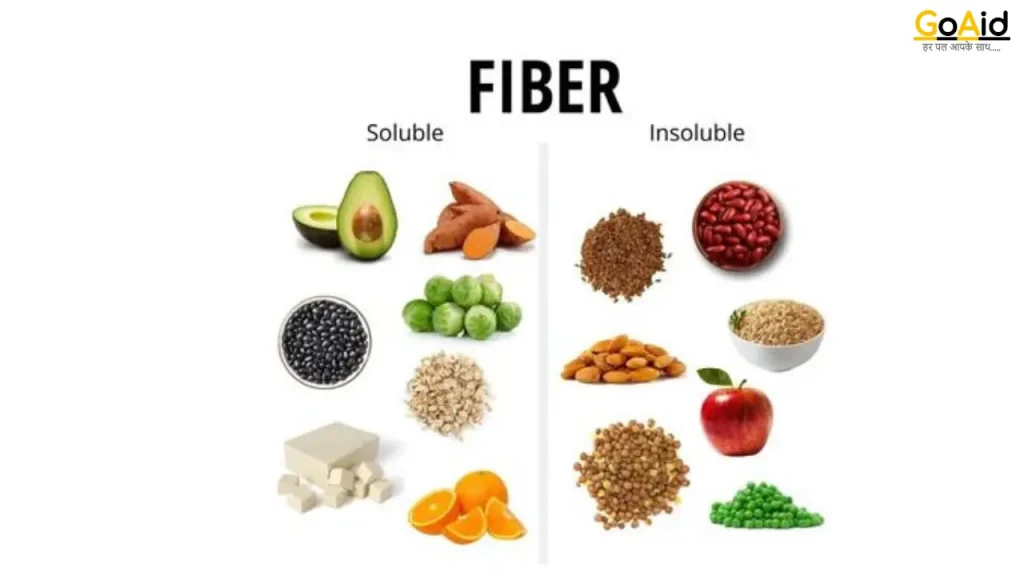
This is a detailed comparison and difference between Soluble Vs. Insoluble Fiber Foods:
Soluble Fiber Foods
Characteristics
- Dissolves in Water: Soluble fiber dissolves or forms a gel-like substance when it comes into contact with water in the digestive tract.
- Digestive Effects: It slows down digestion, which can help regulate blood sugar levels and improve cholesterol levels by binding to cholesterol particles and removing them from the body.
Examples of Soluble Fiber Foods
- Oats: Particularly oat bran and oatmeal.
- Barley: Whole barley or barley flour.
- Legumes: Beans, lentils, peas.
- Fruits: Apples, oranges, berries (strawberries, blueberries).
- Vegetables: Carrots, Brussels sprouts, sweet potatoes.
- Seeds: Chia seeds, flaxseeds.
- Nuts: Especially almonds.
Benefits of Soluble Fiber
- Heart Health: Helps lower LDL (“bad”) cholesterol levels.
- Blood Sugar Control: This slows the absorption of sugar, which can help manage diabetes and prevent spikes in blood glucose levels.
- Weight Management: Provides a feeling of fullness, which can aid in weight control.
Insoluble Fiber Foods
Characteristics
- Does Not Dissolve in Water: Insoluble fiber does not dissolve in water and passes through the digestive system largely intact.
- Digestive Effects: It adds bulk to stool and helps move material through the digestive system, promoting regular bowel movements and preventing constipation.
Examples of Insoluble Fiber Foods
- Whole Grains: Whole wheat, brown rice, quinoa.
- Vegetables: Broccoli, spinach, kale, cauliflower.
- Fruits: Apple skin, pear skin.
- Nuts and Seeds: Almonds, sunflower seeds.
- Legumes: Kidney beans, chickpeas.
Benefits of Insoluble Fiber
- Digestive Health: Supports regular bowel movements and prevents constipation by adding bulk to stool.
- Colon Health: Helps maintain a healthy balance of bacteria in the gut.
- Weight Management: Adds volume to food without adding calories, promoting a feeling of fullness.
Tips for Incorporating Both Types of Fiber
- Balance: Aim for a mix of both soluble and insoluble fiber foods throughout the day for overall digestive health.
- Hydration: Drink plenty of water to help fiber move smoothly through the digestive tract.
- Gradual Increase: Introduce high-fiber foods gradually to avoid digestive discomfort.
- Variety: Include a wide range of fiber-rich foods from different sources to ensure you get a variety of nutrients and benefits.
High-Fiber Snacks for On-The-Go
Having high-fiber snacks on the go is convenient and supports your health goals. HereŌĆÖs a comprehensive guide to high-fiber snacks that are portable and easy to enjoy:
High-Fiber Snacks for On-The-Go
1. Fresh Fruits
- Examples: Apples, bananas, oranges, berries (strawberries, blueberries).
- Fiber Content: Varies by fruit; typically ranges from 2-4 grams per serving.
- Benefits: Provides natural sugars, vitamins, minerals, and antioxidants. Apples with skin are particularly high in soluble fiber (pectin).
2. Raw Vegetables
- Examples: Carrot sticks, celery sticks, cherry tomatoes.
- Fiber Content: Varies; generally 2-3 grams per serving.
- Benefits: Low-calorie, crunchy snacks that provide vitamins, minerals, and insoluble fiber for digestive health.
3. Nuts and Seeds
- Examples: Almonds, walnuts, pumpkin seeds, chia seeds.
- Fiber Content: Almonds (3.5 grams per ounce), walnuts (2 grams per ounce), chia seeds (10 grams per ounce).
- Benefits: Provides healthy fats, protein, and a good mix of soluble and insoluble fiber. Portable and satisfying.
4. Greek Yogurt with Berries
- Examples: Plain Greek yogurt with fresh berries (e.g., strawberries, raspberries).
- Fiber Content: Greek yogurt (around 2 grams per serving), berries (varies by type).
- Benefits: High in protein, probiotics (if yogurt is cultured), and antioxidants from berries. Adds creaminess and sweetness.
5. Whole Grain Crackers with Hummus
- Examples: Whole grain crackers (e.g., whole wheat, rye) with hummus.
- Fiber Content: Whole grain crackers (varies; check labels), hummus (around 2 grams per tablespoon).
- Benefits: Provides complex carbohydrates, protein from hummus, and fiber for sustained energy. Hummus adds flavor and nutrition.
6. Trail Mix
- Ingredients: Mixed nuts (almonds, walnuts), seeds (pumpkin seeds), dried fruits (raisins, cranberries), and whole grain cereal.
- Fiber Content: Varies based on ingredients; typically provides 2-4 grams per serving.
- Benefits: Portable, and provides a mix of nutrients, including healthy fats, protein, and fiber. Offers a satisfying sweet and salty flavor.
7. Popcorn
- Type: Air-popped or lightly salted popcorn.
- Fiber Content: Around 3-4 grams per 3 cups of air-popped popcorn.
- Benefits: Low-calorie, whole grain snack that provides fiber and can satisfy cravings for crunchiness.
8. Fruit and Nut Bars
- Examples: Bars made with nuts, seeds, and dried fruits (check labels for fiber content).
- Fiber Content: Varies by brand and ingredients; typically ranges from 3-5 grams per bar.
- Benefits: Convenient, pre-packaged option that combines healthy fats, protein, and fiber. Provides energy and satisfies hunger.
9. Edamame
- Type: Steamed or roasted edamame (young soybeans).
- Fiber Content: Around 4 grams per half cup.
- Benefits: Provides protein, fiber, and essential nutrients like folate and vitamin K. Easy to carry and eat as a snack.
10. Chia Seed Pudding
- Ingredients: Chia seeds soaked in almond milk or yogurt, sweetened with honey or maple syrup, topped with berries.
- Fiber Content: Chia seeds provide around 10 grams per ounce.
- Benefits: High in omega-3 fatty acids, antioxidants, protein, and fiber. Provides a creamy and satisfying texture.
Tips for Choosing High-Fiber Snacks
- Read Labels: Check nutrition labels for fiber content to choose snacks with at least 3-5 grams of fiber per serving.
- Combine Foods: Pair fiber-rich foods with protein or healthy fats for a balanced snack that keeps you full longer.
- Portion Control: Pack snacks in single-serving containers or portion sizes to avoid overeating.
- Stay Hydrated: Drink water throughout the day to help fiber move through the digestive system smoothly.
Also Read: 7 Most Common Diseases in Summer | Symptoms, Causes, Treatment / Cure ŌĆō A Complete Guide
Fiber Supplements Vs Natural Fiber
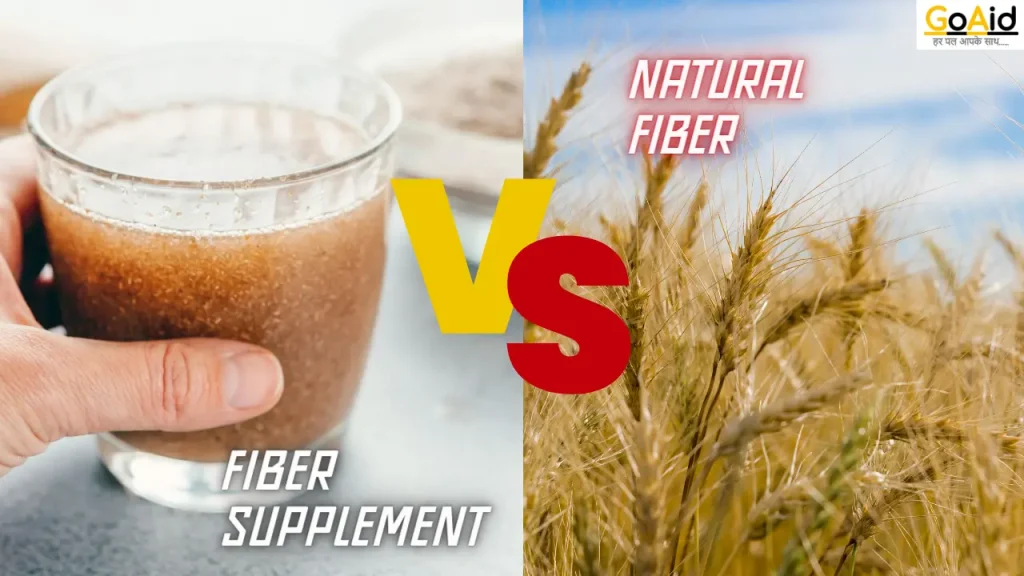
Here are comprehensive details comparing fiber supplements with natural fiber sources:
Fiber Supplements
Types of Fiber Supplements:
- Psyllium Husk: Derived from the seeds of the Plantago ovata plant, it’s a soluble fiber.
- Methylcellulose: Synthetic fiber that absorbs water and bulks up stool.
- Calcium Polycarbophil: Synthetic fiber similar to methylcellulose, used to treat constipation.
- Inulin: Naturally occurring fiber found in chicory root, often used as a prebiotic.
- Wheat Dextrin: Soluble fiber derived from wheat starch, used for its viscosity and bulking effects.
Forms:
- Powder: Mixed with water or juice.
- Capsules or Tablets: Convenient for precise dosing.
- Chewable: Some supplements come in chewable forms for easier consumption.
Benefits of Fiber Supplements:
- Convenience: Easily consumed and dosed, ideal for those with busy lifestyles or specific dietary needs.
- Precision: Exact fiber content per serving, helpful for people needing consistent fiber intake.
- Specific Conditions: Used to manage conditions like constipation or irritable bowel syndrome (IBS).
Considerations:
- Potential Side Effects: Gas, bloating, or abdominal discomfort, especially if not taken with adequate water.
- Interaction with Medications: This may affect the absorption of certain medications; consult a healthcare provider if on medications.
- Not a Replacement: This should complement a diet rich in natural fibers rather than replace it entirely.
Natural Fiber Sources
Types of Natural Fiber:
- Soluble Fiber: Dissolves in water, found in oats, legumes, and fruits like apples and berries.
- Insoluble Fiber: Does not dissolve in water, found in whole grains, and vegetables like broccoli and carrots.
Sources:
- Whole Grains: Brown rice, quinoa, whole wheat bread.
- Fruits: Apples, bananas, oranges, berries.
- Vegetables: Broccoli, spinach, kale, carrots.
- Legumes: Beans, lentils, chickpeas.
- Nuts and Seeds: Almonds, chia seeds, flaxseeds.
Benefits of Natural Fiber:
- Nutrient Rich: Provides vitamins, minerals, and antioxidants essential for overall health.
- Gut Health: Supports healthy digestion and regular bowel movements.
- Weight Management: Helps maintain satiety and manage weight by promoting fullness.
Considerations:
- Variety: Different sources provide different types of fiber, enhancing overall health benefits.
- Hydration: Drinking enough water is crucial to help fiber move through the digestive system.
- Digestive Tolerance: Some high-fiber foods may cause bloating or gas in sensitive individuals; increase intake gradually.
Choosing Between Fiber Supplements and Natural Fiber
Factors to Consider-
- Health Needs: Supplements may be necessary for specific health conditions like constipation or IBS.
- Dietary Preferences: Natural sources provide additional nutrients and health benefits beyond just fiber.
- Balanced Approach: Ideally, combine both supplements and natural sources for comprehensive fiber intake.
- Consultation: Talk to a healthcare provider or dietitian to determine the best approach based on individual health and dietary needs.
How Much Fiber Do I Need Daily
Getting the right amount of fiber daily is crucial for maintaining overall health and supporting proper digestive function. Here’s a comprehensive guide on how much fiber you need daily:
Recommended Daily Fiber Intake
General Guidelines:
- Adult Women: The recommended daily intake of fiber for adult women is around 25 grams per day.
- Adult Men: Adult men should aim for approximately 38 grams of fiber per day.
These recommendations are based on a typical diet of around 2,000 calories per day. However, individual needs may vary based on age, sex, activity level, and overall health.
High-Fiber Foods for A Low-Carb Diet
Incorporating high-fiber foods into a low-carb diet requires choosing sources that are not only rich in fiber but also low in digestible carbohydrates. HereŌĆÖs a detailed guide on high-fiber foods suitable for a low-carb diet:
High-Fiber Foods for a Low-Carb Diet
1. Chia Seeds
- Fiber Content: About 10 grams of fiber per ounce (28 grams).
- Net Carbs: Approximately 1 gram of net carbs per ounce.
- Benefits: Provides omega-3 fatty acids, and antioxidants, and can be used in puddings, smoothies, or as a topping.
2. Flaxseeds
- Fiber Content: Around 8 grams of fiber per 2 tablespoons (20 grams).
- Net Carbs: About 0 grams of net carbs per serving.
- Benefits: Rich in omega-3 fatty acids, and lignans, and can be added to baked goods, yogurt, or smoothies.
3. Avocado
- Fiber Content: Roughly 9 grams of fiber per medium avocado.
- Net Carbs: Approximately 2 grams of net carbs per half avocado.
- Benefits: Provides healthy fats, vitamins, and minerals, and is versatile for salads, spreads, or eaten plain.
4. Broccoli
- Fiber Content: About 5 grams of fiber per cup (91 grams) of cooked broccoli.
- Net Carbs: Around 4 grams of net carbs per cup.
- Benefits: High in vitamin C, vitamin K, antioxidants, and can be steamed, roasted, or added to stir-fries.
5. Brussels Sprouts
- Fiber Content: Approximately 4 grams of fiber per cup (88 grams) of cooked Brussels sprouts.
- Net Carbs: About 7 grams of net carbs per cup.
- Benefits: Rich in vitamin K, vitamin C, antioxidants, and can be roasted, saut├®ed, or added to salads.
6. Almonds
- Fiber Content: Around 3.5 grams of fiber per ounce (28 grams) of almonds.
- Net Carbs: Approximately 2.5 grams of net carbs per ounce.
- Benefits: Provides healthy fats, vitamin E, and magnesium, and is a convenient snack or addition to salads.
7. Berries (e.g., Blackberries, Strawberries)
- Fiber Content: Varies by type; about 3-4 grams of fiber per half cup (72 grams) of blackberries.
- Net Carbs: Roughly 4-5 grams of net carbs per half cup.
- Benefits: Rich in antioxidants, and vitamins, and can be eaten fresh, added to yogurt, or blended into smoothies.
8. Coconut Flour
- Fiber Content: Approximately 10 grams of fiber per 1/4 cup (30 grams).
- Net Carbs: About 6 grams of net carbs per 1/4 cup.
- Benefits: Gluten-free alternative for baking, rich in medium-chain triglycerides (MCTs), and adds texture to recipes.
9. Flaxseed Meal
- Fiber Content: About 4 grams of fiber per 2 tablespoons (14 grams).
- Net Carbs: Approximately 0 grams of net carbs per serving.
- Benefits: Ground flaxseeds are easy to digest and can be used in baking, as a thickener, or added to smoothies.
10. Spinach
- Fiber Content: Around 4 grams of fiber per cup (30 grams) of raw spinach.
- Net Carbs: Approximately 1 gram of net carbs per cup.
- Benefits: Rich in vitamins A, C, K, iron, and antioxidants; versatile for salads, saut├®ing, or added to omelets.
Tips for Including High-Fiber Foods in a Low-Carb Diet
- Portion Control: Monitor portions to keep carb intake low while still benefiting from fiber.
- Hydration: Drink plenty of water to help fiber move through the digestive system.
- Variety: Incorporate a mix of fiber sources to ensure a balanced intake of nutrients.
- Meal Planning: Plan meals and snacks to include high-fiber options without exceeding carb limits.
Book Ambulance: GoAid Ambulance Service
Conclusion to The Ultimate Guide to High-Fiber Foods for a Healthier You
In conclusion, embracing a diet rich in high-fiber foods is a fundamental step towards achieving overall health and wellness. By incorporating a variety of fruits, vegetables, whole grains, nuts, and seeds into your daily meals, you not only promote digestive regularity but also support heart health, weight management, and blood sugar control.
Soluble fiber, found in foods like oats and legumes, aids in lowering cholesterol and stabilizing blood glucose levels, while insoluble fiber, abundant in vegetables and whole grains, promotes healthy digestion and prevents constipation.
This comprehensive guide has covered everything from understanding the types and benefits of dietary fiber to practical tips for increasing intake, along with delicious high-fiber breakfast ideas and convenient snack options. Whether you’re looking to boost fiber on a low-carb diet or considering the pros and cons of fiber supplements versus natural sources, making informed choices can significantly impact your well-being.
If you have any questions or insights about high-fiber foods, feel free to share them in the comment box below. Your journey to a healthier you begins with the power of fiber-rich nutrition.
Frequently Asked Questions related to the Ultimate Guide to High-Fiber Foods for a Healthier You
High-fiber foods include fruits, vegetables, whole grains, nuts, seeds, and legumes that are rich in dietary fiber, and essential for digestive health and overall well-being.
The recommended daily intake is about 25 grams for women and 38 grams for men, promoting regular bowel movements and supporting heart health.
Soluble fiber dissolves in water, forming a gel-like substance, whereas insoluble fiber adds bulk to stool, aiding digestion and preventing constipation.
Benefits include improved digestive health, lowered cholesterol levels, better blood sugar control, and enhanced weight management.
Increase intake by choosing whole grains, adding fruits and vegetables to meals, and incorporating nuts and seeds into snacks.
Yes, fiber-rich foods promote satiety, helping you feel full longer and potentially reducing overall calorie intake.
Options include fruits like apples or bananas, raw vegetables with hummus, or nuts and seeds.
Fiber slows the absorption of sugar, preventing spikes in blood glucose levels and supporting better diabetes management.
Yes, options include quinoa, gluten-free oats, fruits, vegetables, and nuts/seeds, supporting those with gluten sensitivities.
Soluble fiber helps lower LDL cholesterol levels, reducing the risk of heart disease and improving overall cardiovascular health.

